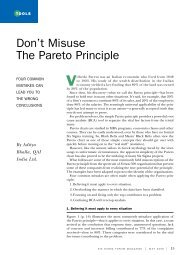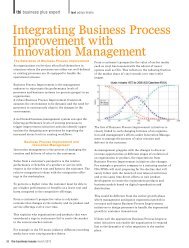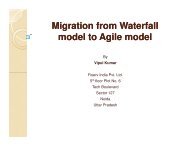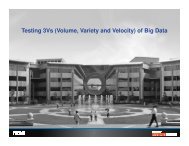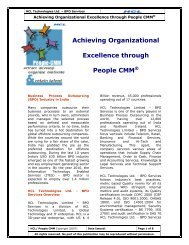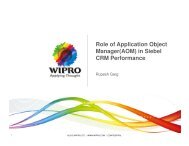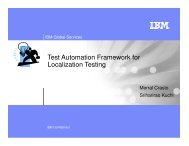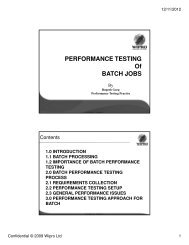Deployment of Earned Value Management Systems in Project ... - QAI
Deployment of Earned Value Management Systems in Project ... - QAI
Deployment of Earned Value Management Systems in Project ... - QAI
Create successful ePaper yourself
Turn your PDF publications into a flip-book with our unique Google optimized e-Paper software.
<strong>Earned</strong> <strong>Value</strong> – a Primer<br />
<strong>Deployment</strong> <strong>of</strong> <strong>Earned</strong> <strong>Value</strong> <strong>Management</strong> <strong>Systems</strong> <strong>in</strong> <strong>Project</strong><br />
Environment<br />
A.What is <strong>Earned</strong> <strong>Value</strong>?<br />
In an ongo<strong>in</strong>g <strong>Project</strong>, the Manager needs to cont<strong>in</strong>ually assess the <strong>Project</strong> Performance<br />
across three primary dimensions – achievement <strong>of</strong> scope, time spent and costs <strong>in</strong>curred.<br />
Depend<strong>in</strong>g on the exigencies, the evolution across these three parameters can vary dynamically<br />
dur<strong>in</strong>g the <strong>Project</strong> Lifecycle.<br />
<strong>Earned</strong> <strong>Value</strong> (EV) is a mechanism to <strong>in</strong>tegrate the technical, Cost and Schedule performance <strong>of</strong><br />
the <strong>Project</strong>. This mechanism can be used dur<strong>in</strong>g the commencement <strong>of</strong> the <strong>Project</strong> to set up<br />
‘<strong>in</strong>tegrated Basel<strong>in</strong>es’, collectively address<strong>in</strong>g the Contractor’s extent <strong>of</strong> Plann<strong>in</strong>g, scope<br />
coverage as laid down <strong>in</strong> the Statement <strong>of</strong> Work (SOW), Schedul<strong>in</strong>g <strong>of</strong> work activities,<br />
resourc<strong>in</strong>g, understand<strong>in</strong>g and address<strong>in</strong>g <strong>of</strong> risks. As the project progresses, the performance<br />
variations from the Basel<strong>in</strong>es are periodically assessed to <strong>in</strong>itiate necessary corrective actions.<br />
The concept <strong>of</strong> EV was developed by the US Department <strong>of</strong> Defense <strong>in</strong> 1967 and used<br />
subsequently by most <strong>of</strong> the major US governmental agencies like NASA, Department <strong>of</strong><br />
Defense etc. Many <strong>of</strong> such organizations stipulate the Contractor to demonstrate their<br />
capability to <strong>in</strong>stitute EV based progress-report<strong>in</strong>g systems as a prerequisite for <strong>Project</strong> awardmaybe<br />
through Tools based report<strong>in</strong>g<br />
B. How EV is useful to the <strong>in</strong>dustry?<br />
The true value <strong>of</strong> the EV lies <strong>in</strong> project progress report<strong>in</strong>g. There is a true equality <strong>of</strong> the<br />
<strong>in</strong>formation shared between the Buyer and the Contractor, through EV based progressreport<strong>in</strong>g<br />
systems enabl<strong>in</strong>g reduction <strong>of</strong> <strong>in</strong>formation asymmetry.<br />
It is a well-established phenomenon that <strong>in</strong>stitution <strong>of</strong> measurement systems leads to<br />
modification <strong>of</strong> the actual behavior. Communication <strong>of</strong> the project progress through EV metrics<br />
<strong>in</strong>culcates cost conta<strong>in</strong>ment consciousness for the Contractors. Establishment <strong>of</strong> such systems<br />
imparts confidence on the Contractors’ progress measurement and the risk management<br />
processes for the Buyer.<br />
EV measurement systems facilitate prediction <strong>of</strong> likely costs and schedules for the <strong>Project</strong>,<br />
enabl<strong>in</strong>g the management to deployment <strong>of</strong> additional resources to focus on gett<strong>in</strong>g <strong>of</strong><br />
additional resources. Some Buyers use EV metrics to <strong>of</strong>fer performance-l<strong>in</strong>ked <strong>in</strong>centives to the<br />
Contractors.<br />
EVM systems are universally applicable across multiple types <strong>of</strong> contracts, <strong>in</strong>clud<strong>in</strong>g<br />
Firm Fixed Price, Cost Plus and Time and material situations- with vary<strong>in</strong>g connotations.<br />
C. How to Set up the EVM systems?<br />
The <strong>Project</strong> <strong>Management</strong> Plan usually <strong>in</strong>cludes the Work Break down structure (WBS), the<br />
<strong>Project</strong> network, and the Cost Basel<strong>in</strong>e, outl<strong>in</strong><strong>in</strong>g the cumulative planned spend<strong>in</strong>g across the<br />
<strong>Project</strong> Life cycle.<br />
- 1 -
The basic component <strong>of</strong> EVM is the WBS – represent<strong>in</strong>g the deliverables to be produced at the<br />
lowest level as Work packages. The l<strong>in</strong>e <strong>of</strong> decomposition <strong>of</strong> Work packages facilitates Activity<br />
def<strong>in</strong>ition, responsibility assignments and management <strong>of</strong> risks at the micro level. Activities get<br />
associated at the Work Package level.<br />
EV can be tracked at the Activity level or the Deliverable level. The activities controlled by<br />
s<strong>in</strong>gle manager get grouped together as Control Account Plan (CAP), which usually co<strong>in</strong>cides<br />
with the EVM report<strong>in</strong>g levels. Thus, <strong>in</strong> effect, CAPs are derived by tak<strong>in</strong>g WBS and<br />
Organisational Breakdown Structures (OBS) together <strong>in</strong>to account.<br />
Cost Basel<strong>in</strong>es are derived from planned resource allocations and resource rates across the<br />
<strong>Project</strong> lifecycle. This Basel<strong>in</strong>e represents Budgeted Cost <strong>of</strong> Work Scheduled (BCWS), which is<br />
also called the Planned <strong>Value</strong> (PV) for the project. (Note – BCWS etc were nomenclature used<br />
<strong>in</strong> earlier versions <strong>of</strong> application <strong>of</strong> the method and are reta<strong>in</strong>ed for understand<strong>in</strong>g purposes<br />
only)<br />
Most <strong>of</strong> the <strong>Project</strong>s use automated <strong>Project</strong> <strong>Management</strong> Information <strong>Systems</strong> (PMIS) to<br />
load cost data dur<strong>in</strong>g the <strong>Project</strong> execution. Typically, the actuals vary from budgets<br />
due to multiple factors – <strong>in</strong>clud<strong>in</strong>g resource usages, resource rates and difference <strong>in</strong> the tasks<br />
performed as compared to schedule. The cumulative costs <strong>in</strong>curred dur<strong>in</strong>g the <strong>Project</strong> life<br />
cycle get plotted as the Actual Cost <strong>of</strong> Work Performed (ACWP), also called Actual Costs (AC)<br />
currently.<br />
The next element <strong>in</strong> the EV <strong>Management</strong> system is to determ<strong>in</strong>e the Budgeted Costs <strong>of</strong> Work<br />
performed. ( BCWP) – which is also commonly known as the <strong>Earned</strong> <strong>Value</strong> (EV). Here<strong>in</strong>, we<br />
assess the extent <strong>of</strong>work performed at any time and relate it to the orig<strong>in</strong>al budgets. BCWP can<br />
be determ<strong>in</strong>ed <strong>in</strong> different ways:<br />
- Based on Task percent completion, prorate the budgeted costs<br />
- Load<strong>in</strong>g EV accruals for <strong>in</strong>termediate Phases<br />
EV Calculation for assessment <strong>of</strong> current performance<br />
At any <strong>in</strong>termediate po<strong>in</strong>t dur<strong>in</strong>g the <strong>Project</strong>, we have three factors:<br />
a) Actual Costs (AC) : Actual Costs <strong>of</strong> the Work Performed so far, which get typically<br />
accumulated via the <strong>Project</strong> Account<strong>in</strong>g system established for the <strong>Project</strong>.<br />
b) Planned <strong>Value</strong> (PV) which is the Budgeted Cost <strong>of</strong> Work Scheduled so far.<br />
c) <strong>Earned</strong> <strong>Value</strong> (EV), which is the Budgeted Cost <strong>of</strong> Work Performed so far.<br />
Above three factors are basic to EV calculations.<br />
The variance <strong>of</strong> actual performance with planned schedule arises on account <strong>of</strong> slippages <strong>of</strong><br />
two k<strong>in</strong>ds:<br />
A) Schedule slippage: Tasks are not gett<strong>in</strong>g completed as per planned schedule. This is<br />
measured by Schedule Variance (SV), as EV – PV or Schedule Performance Index (SPI), which is<br />
computed as EV/PV.<br />
At the reference time po<strong>in</strong>t, this formula computes the ratio <strong>of</strong> the value <strong>of</strong> the Work<br />
performed to the value <strong>of</strong> the Work Scheduled. As expected, any value <strong>of</strong> SPI greater than 1 is<br />
favorable for the <strong>Project</strong> <strong>Management</strong>.<br />
- 2 -
B) Cost Slippage: It is quite likely that the <strong>Project</strong> is on schedule but beh<strong>in</strong>d <strong>in</strong> cost<br />
performance. This phenomenon typically occurs due to overspend<strong>in</strong>g as compared to budgets.<br />
The performance metric for measur<strong>in</strong>g Cost slippage is Cost variance (CV), which is computed<br />
as EV-AC. In ratio terms – Cost Performance Index (CPI) is calculated as EV/AC.<br />
At the reference po<strong>in</strong>t aga<strong>in</strong>, CPI calculates the ratio <strong>of</strong> Budgeted costs to Actual costs for the<br />
work performed. As with SPI, any value <strong>of</strong> CPI greater than 1 is advantageous to <strong>Project</strong><br />
<strong>Management</strong>.<br />
SPI and CPI vary dynamically across the <strong>Project</strong> Lifecycle and could fluctuate <strong>in</strong> different<br />
directions depend<strong>in</strong>g on schedule and cost efficiency <strong>of</strong> the project performance.<br />
A composite <strong>in</strong>dex - CSI (Cost-Schedule Performance Index), def<strong>in</strong>ed as CPI x SPI., measures<br />
the comb<strong>in</strong>ed performance on schedule and cost fronts.<br />
The <strong>in</strong>dices are used for measur<strong>in</strong>g the current performance <strong>of</strong> the <strong>Project</strong> and for future<br />
prediction.<br />
D. Use <strong>of</strong> EV for future predictions<br />
Under the assumption that the current efficiencies <strong>in</strong> the cost and time fronts cont<strong>in</strong>ue to<br />
prevail, CPI and SPI can be used to predict for future.<br />
If BAC (Budgeted at Completion) is the orig<strong>in</strong>al budget <strong>of</strong> the <strong>Project</strong>, then BAC/CPI gives an<br />
estimate <strong>of</strong> the likely total spend<strong>in</strong>g on the <strong>Project</strong> at completion. (This is also known as<br />
Estimate at Completion – EAC).<br />
Adjustment for both Schedule and Cost Parameters – gives a future Cost prediction <strong>of</strong><br />
EAC = AC + (BAC-EV)/(CPI*SPI)<br />
Similarly, if OSAC is the orig<strong>in</strong>al Scheduled at Completion, then OSAC/SPI gives an estimate<br />
<strong>of</strong> the revised schedule for completion, which may be termed as Likely Schedule at<br />
Completion ( or LSAC).<br />
Thus (OSAC, BAC) represent the orig<strong>in</strong>al coord<strong>in</strong>ates as per the Plan and (LSAC, EAC) represent<br />
the expected durations and costs at the end <strong>of</strong> the project, based on the current progress so<br />
far. Of course, it is possible to compute these statistics for any <strong>in</strong>terim milestone also.<br />
The report<strong>in</strong>g periodicity can be pre determ<strong>in</strong>ed with the Contractor for various Control<br />
Account Plans and for the overall <strong>Project</strong>. Significant variations between the planned and<br />
actual performances may call for rebasel<strong>in</strong><strong>in</strong>g, which the <strong>Project</strong> Manager has to undertake,<br />
through established Change Control Procedures.<br />
E.Which are the <strong>in</strong>dustry standards for EVM?<br />
ANSI/EIA standard 748 Industry Guidel<strong>in</strong>es for EVM as a part <strong>of</strong> Cost/Schedule Control <strong>Systems</strong><br />
(C/ SCS) to be followed by the organizations.<br />
These guidel<strong>in</strong>es cover multiple aspects <strong>in</strong>clud<strong>in</strong>g the Organization, Plann<strong>in</strong>g, Schedul<strong>in</strong>g, and<br />
Budget<strong>in</strong>g, Account<strong>in</strong>g Analysis and <strong>Management</strong> Reports, Revisions and Data<br />
Ma<strong>in</strong>tenance standards to be used by the Organizations. In all, 32 criteria have been laid down<br />
<strong>in</strong> the ANSI standards, significant <strong>of</strong> these <strong>in</strong>clude:<br />
- 3 -
Integration <strong>of</strong> the organization’s WBS and OBS to permit measurement by tasks and<br />
resources<br />
Clear identification <strong>of</strong> <strong>in</strong>terdependencies <strong>of</strong> tasks to be performed and the<br />
authorizations systems <strong>in</strong>volved<br />
Identification and <strong>in</strong>corporation <strong>of</strong> <strong>in</strong>direct costs and overheads cutt<strong>in</strong>g across multiple cost<br />
elements<br />
Sett<strong>in</strong>g up <strong>of</strong> report<strong>in</strong>g periodicities, report<strong>in</strong>g structures and Change control systems<br />
F. What are the challenges fac<strong>in</strong>g computation <strong>of</strong> EVM?<br />
Good PMIS tools are needed to support EVM – the depth <strong>of</strong> support varies across the<br />
Tools.<br />
A complex project has multiple streams <strong>of</strong> costs pour<strong>in</strong>g <strong>in</strong>. Some <strong>of</strong> these elements can be<br />
measured through direct costs and others through <strong>in</strong>direct cost<strong>in</strong>g processes. Organizational<br />
Chart <strong>of</strong> Accounts and Work authorization policies play a significant role <strong>in</strong> sett<strong>in</strong>g up <strong>of</strong> the<br />
EVM systems.<br />
Most <strong>of</strong> the EV Packages enable <strong>in</strong>corporation <strong>of</strong> account<strong>in</strong>g pr<strong>in</strong>ciples. These <strong>in</strong>clude Activity<br />
Based Cost<strong>in</strong>g, Allocation <strong>of</strong> Direct and Overhead costs, Resource Burden<strong>in</strong>g, <strong>in</strong>terfac<strong>in</strong>g to<br />
organizational f<strong>in</strong>ancial systems etc.<br />
On the Human resources front, the systems need to collect the resource rates, timesheet<br />
<strong>in</strong>terfac<strong>in</strong>g, hours worked, whether they are used directly or <strong>in</strong>directly for the <strong>Project</strong> etc.<br />
EVM is not very useful for mov<strong>in</strong>g scope <strong>Project</strong>s or when basel<strong>in</strong>es get shifted frequently due<br />
to external constra<strong>in</strong>ts. Also, measurement <strong>of</strong> EVM <strong>in</strong> <strong>in</strong>tellectual type <strong>of</strong> work ( as <strong>in</strong> S<strong>of</strong>tware<br />
development) can be subjective – when it comes to measurement <strong>of</strong> extent <strong>of</strong> work ‘done’ – <strong>in</strong><br />
between milestones. A good way <strong>in</strong> this context is to have closely paced milestones ( say not<br />
more than a week apart) and use 20/80 load<strong>in</strong>g rule for measur<strong>in</strong>g the value <strong>of</strong> work <strong>in</strong><br />
between milestones.<br />
More <strong>of</strong>ten than not, <strong>Project</strong> <strong>Management</strong> and the Bus<strong>in</strong>ess <strong>Management</strong> need to understand<br />
the significance <strong>of</strong> various EVM parameters, for proper <strong>in</strong>terpretation and action. EVM works<br />
well <strong>in</strong> a contractual context but for <strong>in</strong>ternal <strong>Project</strong>s, the costs may have to be substituted by<br />
efforts.<br />
- 4 -



